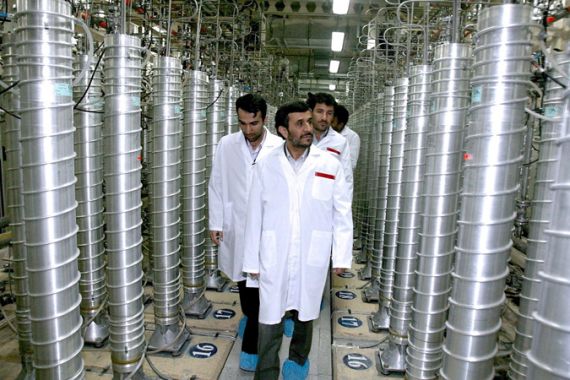IAEA: Iran ready to boost uranium enrichment
UN’s nuclear watchdog says Tehran now capable of significantly expanding uranium enrichment after equipping key plant.

Iran is set to sharply expand its uranium enrichment in an underground site after installing all the centrifuges it was built for, a report by the International Atomic Energy Agency (IAEA) has said.
The UN’s nuclear watchdog also said that Iran’s stockpile of its most sensitive nuclear material, which could relatively quickly be used to make atomic arms, had grown and is getting closer to an amount that could be sufficient for a bomb.
Keep reading
list of 4 itemsTurtles swimming to extinction in Malaysia as male hatchlings feel heat
Could shipping containers be the answer to Ghana’s housing crisis?
Thousands protest against over-tourism in Spain’s Canary Islands
The IAEA said on Friday that the installation of equipment at Iran’s Fordo uranium enrichment plant was now “complete”.
The agency report reiterated its regular statement that it was “unable … to conclude that all nuclear material in Iran is in peaceful activities”.
It also said that activities spotted by satellite at the Parchin military base, where the IAEA says it has evidence of possible past nuclear weapons research work, meant that any verification there would be “seriously undermined”.
Iran denies working, or ever having worked, on a nuclear weapon and says all its atomic activities are peaceful.
Weapons-grade uranium
If Iran uses the new machinery at Fordo to enrich uranium to purities of 20 per cent, technically not far from the level needed for a bomb, production could increase from 15 kilos per month now to about 45 kilos, a source familiar with the matter said.
Experts say that about 250 kilos of 20-per cent uranium is needed to convert into enough 90-per cent material for one nuclear weapon.
Deciding to “break out” and enrich to this level would however quickly be detected by the IAEA.
Making a bomb also requires a whole range of other activities.
“Iran remains years, not months away from having a workable nuclear arsenal if it were to choose to pursue that capability,” analyst Daryl Kimball of the Arms Control Association said.
John Large, a nuclear analyst, told Al Jazeera that the IAEA report comes at a very sensitive time.
“What is interesting is that the IAEA actually published this report now, when the geo-political situation is so sensitive. It is not experts like me or Western politicians that we should be concerned about, but Israel’s interpretation of the Iranian moves that is the real problem here.
“The Israelis may well see the advancement of missile technology that now the Gaza Strip is firing at them… the ones that reached Tel Aviv have been made in Iran and they could use that as a political excuse (to attack Iran).”
‘Ready for feeding’
Since its last report in August, Iran has installed about 640 new centrifuges – machines that enrich uranium gas by spinning it at supersonic speeds – at Fordo, and a further 700 are “ready for feeding”, the IAEA report said.
No new centrifuges were put into operation since the last report, however, it said.
The report also indicated that Iran had converted about 40 per cent of its around 230 kilos of 20-per cent uranium into a form for use in a research reactor, making it much harder to convert for use in a weapon.
Many in the international community worry that by the time Fordo is fully up and running, Iran will be producing far more 20-per cent-enriched uranium than Iran’s civilian nuclear activities can conceivably need.
Iran “appears to be calibrating the progress so as not to make huge advances at once that could spark a crisis,” Mark Fitzpatrick from the International Institute for Strategic Studies think-tank in London told the AFP news agency.
“The situation might be likened to the frog in the hot pot, with the temperature being turned up only slowly,” he said.
Sanctions
Because of worries about Iran’s aims, the UN Security Council has passed six resolutions calling on Tehran to suspend all enrichment, including to lower levels, passing four rounds of sanctions.
Western nations have imposed additional sanctions that this year have begun to hit the Iranian economy hard.
Israel, the Middle East’s sole, if undeclared, nuclear-weapons state, has refused to rule out military action to stop Iran also getting the bomb. Fordo is dug into a mountainside and therefore difficult to bomb.
A nuclear bomb needs more than uranium, and exactly a year ago the IAEA released a major report setting out a large body of what it called “overall, credible” evidence suggesting activity in other areas – at least until 2003 and possibly since – including at Parchin.
Twelve months on, and despite a string of fruitless meetings in Vienna and Tehran, Iran continues to reject the findings in that report, dismissing them as forgeries provided by foreign intelligence services.
In September, the head of Iran’s atomic agency, in a speech at the IAEA’s annual meeting of all member states, accused the UN body of being infiltrated by saboteurs and “terrorists”.
A senior figure familiar with the situation said on Friday that as a result of Fereydoon Abbasi Davani’s comments, IAEA inspectors in Iran were working under an “atmosphere of intimidation”.
IAEA head Yukiya Amano expressed guarded optimism on Sunday that the next meeting, set for December 13 in the Iranian capital, would be more productive.